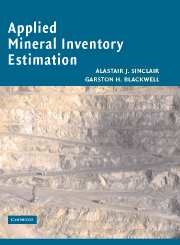Book contents
- Frontmatter
- Contents
- Preface
- Acknowledgments
- 1 MINERAL INVENTORY: AN OVERVIEW
- 2 GEOLOGIC CONTROL OF MINERAL INVENTORY ESTIMATION
- 3 CONTINUITY
- 4 STATISTICAL CONCEPTS IN MINERAL INVENTORY ESTIMATION: AN OVERVIEW
- 5 DATA AND DATA QUALITY
- 6 EXPLORATORY DATA EVALUATION
- 7 OUTLIERS
- 8 AN INTRODUCTION TO GEOSTATISTICS
- 9 SPATIAL (STRUCTURAL) ANALYSIS: AN INTRODUCTION TO SEMIVARIOGRAMS
- 10 KRIGING
- 11 GLOBAL RESOURCE ESTIMATION
- 12 GRADE-TONNAGE CURVES
- 13 LOCAL ESTIMATION OF RESOURCES/RESERVES
- 14 AN INTRODUCTION TO CONDITIONAL SIMULATION
- 15 BULK DENSITY
- 16 TOWARD QUANTIFYING DILUTION
- 17 ESTIMATES AND REALITY
- 18 RESOURCE/RESERVE CLASSIFICATION
- 19 DECISIONS FROM ALTERNATIVE SCENARIOS: METAL ACCOUNTING
- APPENDICES
- Bibliography
- Index
Preface
Published online by Cambridge University Press: 19 August 2009
- Frontmatter
- Contents
- Preface
- Acknowledgments
- 1 MINERAL INVENTORY: AN OVERVIEW
- 2 GEOLOGIC CONTROL OF MINERAL INVENTORY ESTIMATION
- 3 CONTINUITY
- 4 STATISTICAL CONCEPTS IN MINERAL INVENTORY ESTIMATION: AN OVERVIEW
- 5 DATA AND DATA QUALITY
- 6 EXPLORATORY DATA EVALUATION
- 7 OUTLIERS
- 8 AN INTRODUCTION TO GEOSTATISTICS
- 9 SPATIAL (STRUCTURAL) ANALYSIS: AN INTRODUCTION TO SEMIVARIOGRAMS
- 10 KRIGING
- 11 GLOBAL RESOURCE ESTIMATION
- 12 GRADE-TONNAGE CURVES
- 13 LOCAL ESTIMATION OF RESOURCES/RESERVES
- 14 AN INTRODUCTION TO CONDITIONAL SIMULATION
- 15 BULK DENSITY
- 16 TOWARD QUANTIFYING DILUTION
- 17 ESTIMATES AND REALITY
- 18 RESOURCE/RESERVE CLASSIFICATION
- 19 DECISIONS FROM ALTERNATIVE SCENARIOS: METAL ACCOUNTING
- APPENDICES
- Bibliography
- Index
Summary
“ … geostatistics is of real potential if it is reconciled with the geology of the deposit”
(King et al., 1982).Resource/reserve estimation is too often viewed as a set of recipes when it is in reality an intellectual undertaking that varies from one case to another. Even the estimation of two different deposits of the same type can involve significantly different procedures. We undertake an estimation study with limited information that represents perhaps 1/100,000 of the deposit in question. The information base, however, is larger than we sometimes think, including not just general geology and assay data, but information from other sources such as sampling practice, applied mineralogical studies, geophysical and geochemical survey data, and a range of engineering information – all of which contribute to the development and implementation of an estimation procedure. The use of such varied data demands that the opinions of a range of experts be taken into account during estimation. Increasingly, it is becoming more difficult for a single person to conduct a comprehensive resource/reserve estimation of a mineral deposit. Clearly, all sources of information must be considered in reasonable fashion if a mineral inventory study is to be professionally acceptable; it is morally unacceptable to provide an estimate that is seriously in conflict with pertinent data. Of course, it must be recognized that even with the best of intentions, procedures and abilities, errors will be made. After all, 99,999/100,000 of the deposit must be interpreted from widely spaced control sites.
- Type
- Chapter
- Information
- Applied Mineral Inventory Estimation , pp. xiii - xviPublisher: Cambridge University PressPrint publication year: 2002

